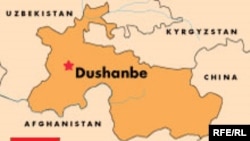Health officials at the scene suspect the sudden infections might be the result of recent work on the public water system. In a strange twist, the replacement of old pipes had been financed by the Aga Khan Foundation, a nonprofit group that has spent a decade doing good deeds in the region.
NGO Role?
Officials appear to have seized on that organization's role to deflect potential public anger.
Deputy Health Minister Nigina Sharofova stressed the local nature of the outbreak at a news conference on April 19.
"So that there won't be any panic: The reason [for the outbreak] was that the Aga Khan Foundation installed water pipes in that area, and it happened that new pipes were connected to old pipes," Sharofova said. "And many dead rats other filth was found in those [old] pipes, and in those parts where the [new and old] pipes were connected -- where the old pipes ended -- that is where the outbreak was registered."
Sharofova said prosecutors have launched an investigation into the appearance of the disease.
A History Of Helping
The Aga Khan Foundation has worked for more than 10 years in Tajikistan and neighboring Kyrgyzstan, helping repair damaged or old sections of the infrastructure. It has backed improvements to water pipes and power supplies, as well as provided farming aid to rural communities.
RFE/RL's Tajik Service contacted a representative of the Aga Khan Foundation in the Tajik capital Dushanbe.
Representative Mizrob Amirbekov told RFE/RL's Tajik Service that it was not his foundation's work, but unsanitary conditions that spread the disease.
"According to our representatives, that [outbreak] is not related to our pipelines. There is no evidence that the pipes have microbes or viruses," Amirbekov said. "Most probably, it came from the soil and from the health-care situation."
Methods Of Transmission
The deputy head of Tajikistan's national epidemiological center, Issakhan Gurezov, tended to discount the supposition that the pipes were responsible.
"The disease could be spread first by animals. Then it could infect people through water or food," Gurezov said. "It is not passed from person to person. It could spread from time to time in different places, but not everywhere."
RFE/RL spoke with Dr. Tom Clark the U.S. Center for Disease Control in Atlanta, Georgia. He highlighted the serious nature of the disease, and he stressed the likelihood of its transmission through contact with animals or tainted water supplies.
"People contract the infection from animals -- either directly by exposure to animal tissues or carcasses -- or more commonly by exposure to animal urine," Clark said. "And most people really get the infection from exposure to animal urine that's contaminating surface waters -- rivers or streams or lakes or stagnant water that may have animal urine in it."
Clark noted that the disease is not communicable through human contact. He also offered ways to avoid contracting the disease: boiling or otherwise treating drinking water to kill the leptospira bacteria, and avoiding skin contact with water in which animals have urinated.
There have been occasional outbreaks of leptospirosis in Central Asia in the past. But the last time Tajik authorities recorded a case was the early 1990s.
(Salimjon Aioubov of RFE/RL's Tajik Service contributed to this report.)









